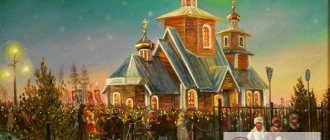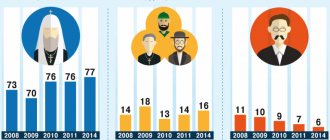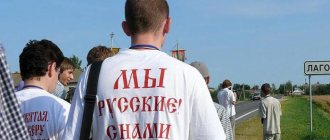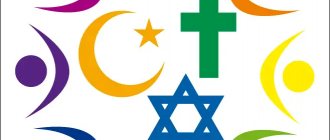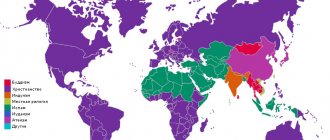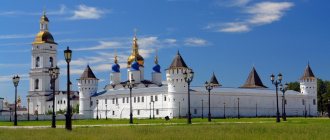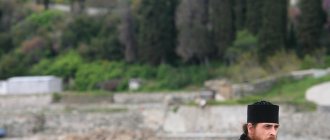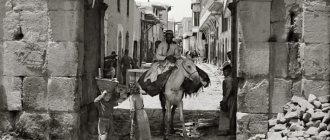Russia is one of the most multinational states in the world, home to about 180 peoples
. Because Since Russia's borders are located on the territory of the European and Asian continents, the ethnic diversity of the country has historically been formed from the two largest human races - Caucasoid and Mongoloid.
The very concept of people (or “ethnic group”) means a historically established group of people connected by common external characteristics, language, territory of residence, culture, way of life
etc.
The diversity of the peoples of Russia is explained primarily by its geographical location
. For more than a thousand years of history, Russia has annexed new lands to its territory, inhabited by peoples of other cultures, who contributed to the formation of the Russian nation. Russia also experienced long periods of conquest and raids from neighboring empires (for example, the rule of the Tatar-Mongol yoke), whose peoples left a noticeable mark on the modern ethnic composition of the country.
Religion of Russia
Russia is a multi-religious country , which means that different religions coexist on its vast territory and the main ones are Christianity, Islam, Judaism and Buddhism . Supporters of each adhere to their traditions, honoring and carefully passing them on to their descendants and followers.
The preservation and restoration of spiritual monuments today is controlled at the state level, and pilgrimage tourism in Russia is becoming increasingly popular.
We invite you to a virtual tour of the most unique and original religious architectural monuments of Russia, which are certainly worth visiting in person.
• Kizhi is a pearl of wooden architecture, which rightfully tops the list of the 10 most beautiful churches in Russia, is a UNESCO World Heritage Site and a center of attraction for Orthodox Christians from all over the world. The attraction is located on the island of Kizhi, surrounded by the waters of Lake Onega. The architectural ensemble consists of a tented bell tower, the Transfiguration and Intercession churches, which, according to legend, were built without a single nail. Walking around the island, you can look into the house of a Russian peasant and see with your own eyes that Christianity has been inseparably linked with the Russian people since ancient times. Russia, Republic of Karelia, Kizhi Island • The main cathedral mosque of Kazan, Kul Sharif, is only 15 years old, but its history goes back centuries. Kul Sharif is an architectural copy of the Al-Kabir Mosque, a symbol of Volga Islam, located in the Kazan Khanate until the 16th century. Externally, the dome of the mosque resembles the “Kazan hat” that local khans used to wear, and inside the dome is decorated with a Czech glass chandelier weighing more than 2.5 tons. The decoration of the mosque is made of Krasnodar oak, Ural marble, crystal and gold. On religious holidays, the mosque accommodates almost two thousand Muslim believers, becoming one of the main prayer centers in Russia. Russia, Republic of Tatarstan, city of Kazan
• The Great Choral Synagogue is one of the spiritual centers of Jews in Russia and the second largest synagogue in Europe after the one in Budapest. The architectural design of the synagogue was developed with the participation of the chief architect of Peterhof, Nikolai Benois, and approved by Emperor Alexander II. Even during the construction of the synagogue, the sale of seats on the benches began, some of which were purchased for life by St. Petersburg patrons of the arts. It is worth noting that the benches built in pre-revolutionary times have still been preserved. The picturesque spiral staircase leading to the organ and choir also conveys the spirit of that time and creates a special atmosphere. The synagogue is worth visiting for anyone who professes Judaism or is interested in the history of religion. The synagogue regularly hosts excursions, during which, for example, you have the opportunity to visit the wedding hall and see how a traditional Jewish wedding takes place. Russia, city of St. Petersburg
• Ivolginsky datsan is part of a complex of Buddhist temples and the place that marked the beginning of the revival of Buddhism back in Soviet times. The temple is widely known to tourists around the world not only for its authentic architecture, prayer wheels, but also for the fact that it is here that the incorruptible body of Dorzho Itigelov, who proved that all people are immortal, is located. Buddhist pilgrims dream of touching the incorruptible lama, because this promises good luck in all matters, and tourists are interested in looking at a man who has been in a state of nirvana for almost 100 years. Russia, Republic of Buryatia, village of Verkhnyaya Ivolga
Spiritual shrines in Russia are a kaleidoscope of the brightest architectural monuments and different cultures, which proves that faith lives in the hearts of people. And she is unshakable.
Catholicism
The historical presence of Latin Christianity in the lands of the Eastern Slavs dates back to the early times of Kievan Rus. At different times, the attitude of the rulers of the Russian state towards Catholics changed from complete rejection to benevolence. Currently, the Catholic community in Russia numbers several hundred thousand people.
After the Bolshevik revolution in October 1917, the Catholic Church in Russia continued to operate freely for some time, but from the beginning of the 20s, the Soviet government began a policy of eradicating Catholicism in Russia. In the 20s and 30s of the 20th century, many Catholic priests were arrested and shot, almost all churches were closed and looted. Almost all active parishioners were repressed and exiled. In the period after the Great Patriotic War, only two functioning Catholic churches remained in the RSFSR, the Church of St. Louis in Moscow and the Church of Our Lady of Lourdes in Leningrad.
Since the beginning of the 90s, the Catholic Church has been able to function normally in Russia. Two Apostolic Administrations were created for Latin Rite Catholics, which were later transformed into dioceses; as well as the College of Catholic Theology and the Higher Theological Seminary.
Currently, there are about 230 parishes in Russia [2], a quarter of which do not have church buildings. Organizationally, the parishes are united into four dioceses, which together make up the metropolis:
An estimate of the number of Catholics in Russia can only be approximate. The most commonly cited figures range from 200 to 600 thousand people.
Links
Austria • Albania • Andorra • Belarus • Belgium • Bulgaria • Bosnia and Herzegovina • Vatican City • Great Britain • Hungary • Germany • Greece • Denmark • Ireland • Iceland • Spain • Italy • Kazakhstan¹ • Cyprus¹ • Latvia • Lithuania • Liechtenstein • Luxembourg • Macedonia • Malta • Moldova • Monaco • Netherlands • Norway • Poland • Portugal • Russia¹ • Romania • San Marino • Serbia • Slovakia • Slovenia • Turkey¹ • Ukraine • Finland • France • Croatia • Montenegro • Czech Republic • Switzerland • Sweden • Estonia
Akrotiri and Dhekelia • Åland Islands • Guernsey • Gibraltar • Jersey • Isle of Man • Faroe Islands • Svalbard • Jan Mayen
| Unrecognized and partially recognized states ( de facto independent) | |
| ¹ Mainly in Asia |
Protestantism
Protestantism is represented in Russia by the following denominations [20]:
In 2000, the Advisory Council of Heads of Protestant Churches was created, which included representatives of the largest Protestant churches in Russia: Baptists, Pentecostals and Adventists [21].
Most Russian Protestants recognize the basic values of the Reformation: salvation by faith alone and Scripture alone. In divine services, in addition to the sermon, only two sacraments are important for the correction of life: baptism and communion. However, Evangelical Christian Baptists are distinguished by a Calvinistic approach to the symbolic interpretation of the sacraments, while Lutherans insist on the true presence of God in the sacraments. Baptists also deny the baptism of children, believing that their lack of awareness is an obstacle to performing the sacrament
Lutheranism
Orthodoxy in Russia
Federal Law of September 26, 1997 No. 125-FZ “On Freedom of Conscience and Religious Associations,” which replaced the RSFSR Law of October 25, 1990 No. 267-I “On Freedom of Religion,” contains in the preamble recognition of “the special role of Orthodoxy in history Russia" [3].
Orthodoxy (as the term is understood by government agencies and religious scholars) in the Russian Federation is represented by the Russian Orthodox Church, Old Believer associations, as well as a number of non-canonical (alternative) Orthodox organizations of the Russian tradition.
The Russian Orthodox Church is the largest religious association in Russia; considers itself to be the historically first Christian community in Russia: the official state beginning was laid by the holy Prince Vladimir in 988 ( see article Baptism of Russia
), according to traditional historiography.
( See article Russian Orthodox Church
)
According to the head of the Russian Social Movement, political scientist Pavel Svyatenkov (January 2009), the Russian Orthodox Church de facto occupies a special position in modern Russian society and political life: “The Russian Orthodox Church was allowed to be reborn under Stalin as an institution into which archaic Russianness was channeled . The Russian Orthodox Church is a kind of Russian autonomy within first the USSR and then the Russian Federation. It is the church, standing next to the state, that legitimizes it as the state of the Russian people.” [4]
The largest non-Slavic Orthodox peoples of Russia are the Chuvash, Mari, Mordovians, Komi, Udmurts and Yakuts.
The majority of Ossetians are also Orthodox, making them the only major Orthodox ethnic group in the North Caucasus.
Prevalence of Orthodoxy in Russia
According to a FOM survey, in 2000, 56% of Russian residents considered themselves to be Orthodox. In 2007, according to VTsIOM, 63% of respondents in the Russian Federation considered themselves Orthodox [5] [6] ; according to other data from the same VTsIOM, in total, 55% of respondents said that they “believe in God” (that is, not only Orthodox Christians) in 2007 [7].
Percentage of Russians attending church services
Data are given according to [8].
| Year | 1991 | 1993 | 1994 | 1995 | 1996 | 1997 | 1998 | 2002 | 2003 |
| From 1 to several. once a month | 5 | 5 | 7 | 6 | 7 | 5 | 9 | 8 | 6 |
| From 1 to several. once a year | 20 | 35 | 28 | 30 | 17 | 16 | 22 | 18 | 30 |
| Less often | — | — | 21 | — | 16 | 14 | 11 | 15 | 18 |
| Didn't visit | 65 | 45 | 43 | 63 | 60 | 62 | 55 | 59 | 46 |
| Number of respondents | 3000 | 2000 | 2957 | 1698 | 2404 | 2406 | 1703 | 2107 | 2107 |
Indirect prevalence indicators
Data on church attendance, the attitude of Russians towards Orthodox holidays, commandments, etc. are used as indirect indicators of the prevalence of Orthodoxy in Russia.
According to the Ministry of Internal Affairs, people attending religious services make up less than 2% of the population. Thus, on Easter 2003, in the period from 20:00 Holy Saturday to 6 am of Easter Sunday, according to the Ministry of Internal Affairs, 63 thousand people entered Moscow churches (compared to 180 thousand in 1992-1994), that is, about half of one percent of the actual population of the city. [9]
However, only 6% of Russians go to church more than once a month. 18% of Russians visit churches less than once a year, and 31% visit churches several times a year. [10] .
On January 10, 2008, the head of the press service of the Moscow Patriarchate, priest Vladimir Vigilyansky, disputed the statistics of attendance at the capital’s churches at Christmas, which had previously been cited by law enforcement agencies, saying: “The official figures are very underestimated. It always amazes me where these numbers come from and what the purpose of this approach is. I think we can safely say that about a million believers visited Moscow churches for Christmas this year” [11]. A similar opinion was expressed in April 2008 by DECR employee priest Mikhail Prokopenko. [12]
Notes
- ↑ 12
Religious associations of the Russian Federation. M.: Republic, 1996; Religion, freedom of conscience and state-church relations in Russia. Edition 2. M.: RAGS, 1997 - ↑ 12
Information about religious organizations registered in the Russian Federation - ↑
Federal Law of September 26, 1997 No. 125-FZ “On Freedom of Conscience and Religious Associations” - ↑
Shepherd's goals. Patriarch Kirill will try to become Putin for the church Private correspondent, January 28, 2009. - ↑
Detailed comparative statistics of religiosity in Russia and Poland have been published. Religare.ru website June 6, 2007 - ↑
Article in Gazeta.ru “The Russian Orthodox Church in Russia is a majority that resembles a minority” - ↑
VTsIOM press release No. 679 04/20/2007 - ↑
Boris Dubin. Mass religious culture in Russia (trends and results of the 1990s) - ↑
Nikolai Mitrokhin.
Russian Orthodox Church.
Current status and current problems . M., 2006, p. 40 - ↑
Faith, religion, church. Foundation "Public Opinion" (08/16/2000). - ↑
According to the Moscow Patriarchate, about a million people attended Christmas services in Moscow. Interfax.ru January 10, 2008 - ↑
The real number of people who visited churches on Easter is much higher than the Ministry of Internal Affairs data, according to the Moscow Patriarchate. Interfax.ru April 28, 2008 - ↑ Address of His Holiness Patriarch of Moscow and All Russia Alexy II to the clergy, Parish councils of Moscow churches, governors and abbots of stauropegial monasteries at the Diocesan meeting on December 23, 2003
//
Church Bulletin
. 2003, No. 1 - 2, p. 17 - ↑
https://religion.ng.ru/events/2007-01-17/3_rozhdestvo.html - ↑
https://www.religare.ru/article53383.htm - ↑
https://lenta.ru/news/2008/04/28/darkage/ - ↑
The Kremlin came to faith on the wave of strengthening national self-awareness, says the American newspaper.NEWSru.com December 18, 2007 - ↑
Born Again. Putin and Orthodox Church Cement Power in Russia. by Andrew Higgins: Original article in the Wall Street Journal, December 18, 2007. - ↑
https://www.religare.ru/2_61871.html - ↑
Sergey Ivanenko. Protestants in modern Russia: problems of typology, determining their numbers and acquiring the status of a social partner of state institutions by authoritative Protestant associations - ↑
The Advisory Council of Heads of Protestant Churches in Russia discussed state-church relations in Moscow

